 |
|
Travis Air Force Base Airport |
| Travis Air Force Base
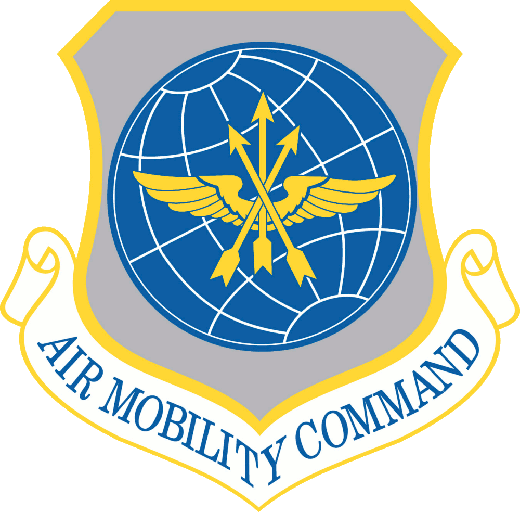
Air Mobility Command
|
 |
| Aerial image - 17 June 1993 |
| IATA: SUU – ICAO: KSUU – FAA LID: SUU |
| Summary |
| Airport type |
Military: Air Force Base |
| Owner |
United States Air Force |
| Operator |
Air Mobility Command |
| Location |
Fairfield, California |
| Built |
1942 |
| Occupants |
60th Air Mobility Wing |
| Elevation AMSL |
62 ft / 19 m |
| Coordinates |
38°15′46″N 121°55′39″W / 38.26278°N 121.9275°W / 38.26278; -121.9275Coordinates: 38°15′46″N 121°55′39″W / 38.26278°N 121.9275°W / 38.26278; -121.9275 |
| Website |
http://www.travis.af.mil/ |
| Runways |
| Direction |
Length |
Surface |
| ft |
m |
| 3L/21R |
11,001 |
3,353 |
PEM |
| 3R/21L |
10,992 |
3,350 |
Concrete |
| Sources: official web site and FAA |
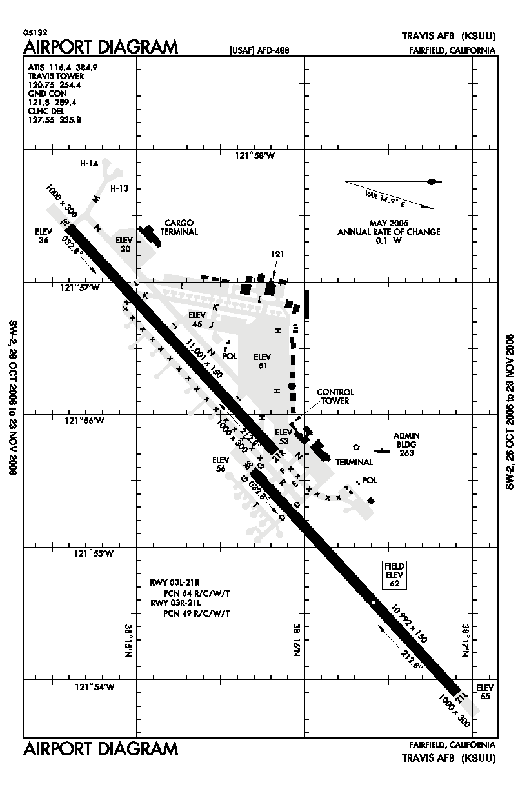 | |
FAA Airport Diagram |
Travis Air Force Base (IATA: SUU, ICAO: KSUU, FAA LID: SUU) is a United States Air Force air base under the operational control of the Air Mobility Command (AMC), located three miles (5 km) east of the central business district of Fairfield, in Solano County, California, United States. The base is named for Brigadier General Robert F. Travis, who died in the crash of a B-29 Superfortress while transporting a nuclear weapon. Units
The host unit at Travis AFB is the 60th Air Mobility Wing. The 60th AMW is the largest wing in the Air Force's Air Mobility Command, with a versatile fleet of C-5 Galaxies, KC-10 Extenders, and C-17 Globemaster III aircraft.
Components of the 60th AMW are:
- 60th Aircraft Maintenance Squadron
- Provides combat-ready maintenance personnel and organizational support to inspect, service, and repair assigned C-5 aircraft, and maintenance support for Transient Alert. Generates 24-hour-a-day strategic airlift to support four flying squadrons and ensures readiness of personnel and equipment for deployment. Maintains mission ready aircraft capable of worldwide strategic airlift supporting AMC's global mission.
- 660th Aircraft Maintenance Squadron
- Provides combat-ready maintenance personnel and organizational support to inspect, service, and repair all transient and assigned KC-10A aircraft, 46% of DOD's inventory. Generates aerial refueling and strategic airlift to support flying activities of four aerial refueling squadrons. Ensures readiness of personnel and equipment for deployment. Maintains mission capable aircraft supporting AMC's global mission.
- 60th Equipment Maintenance Squadron
- Provides organizational and field-level aircraft maintenance, repair, and manufacture capability for effective on- and off-equipment maintenance, inspection and refurbishment of C-5 and KC-10 aircraft. Inspects, services, and overhauls aerospace ground equipment worth over $8 million. Manages and stores all base munitions. Provides mission capable aircraft in direct support of AMC’s global mission.
- 60th Component Maintenance Squadron
- Inspects, services, and overhauls aircraft fuel systems for C-5, C-17 and KC-10 aircraft. Maintains avionic, hydraulic, electrical and environmental system components for C-5 and C-17 aircraft. Operates the west coast TF39 Engine Regional Repair Center. Calibrates and repairs over 8,800 items in a regional Test, Measurement, and Diagnostic Equipment Laboratory. Directly supports AMC’s global reach mission for AMC’s largest wing.
- The 60EMS and 60CMS merged together to become the 60th Maintenance Squadron on 1 July 2008
- 60th Maintenance Operations Squadron
- Provides critical support for the maintenance, modification and scheduling of C-5 and KC-10 aircraft valued at $9B. Controls maintenance actions and manages all aircraft and mission statistics. Manages $340M in real property and provides group-level mobility support for AMC's largest wing. Develops and executes aircraft/ancillary training and provides aircraft maintenance training support for the Pacific Rim.
- 860th Aircraft Maintenance Squadron
- Provides combat-ready maintenance personnel and organizational support to inspect, service, and repair assigned C-17A aircraft, and maintenance support for Transient Alert. Generates 24-hour-a-day strategic airlift to support two flying squadrons and ensures readiness of personnel and equipment for deployment. Maintains mission ready aircraft capable of worldwide strategic airlift supporting AMC's global mission.
Other units
- 15th Expeditionary Mobility Task Force
- 60th Medical Group
- 349th Air Mobility Wing (Air Force Reserve Command)
- US Army’s 3d Brigade, 91st Division (Training Support)
- US Navy Fleet Air Reconnaissance Squadron THREE (VQ-3) Detachment (TACAMO)
Overview
Situated in the San Francisco Bay Area and known as the "Gateway to the Pacific", Travis Air Force Base handles more cargo and passenger traffic through its airport than any other military air terminal in the United States. The base has a long and proud history of supporting humanitarian airlift operations at home and around the world. Today, Travis AFB includes approximately 7,260 active USAF military personnel, 4,250 Air Force Reserve personnel and 3,770 civilians.
Travis AFB has a major impact on the community as a number of military families and retirees have chosen to make Fairfield their permanent home. Travis AFB is the largest employer in the City and Solano County as well, and the massive Travis workforce has a local economic impact of more than $1 billion annually. The Base also contributes a large number of highly skilled people to the local labor pool.
In addition, the base's former Strategic Air Command Alert Facility is now a U.S. Navy complex that typically supports 2 transient Navy E-6B Mercury TACAMO aircraft assigned to Fleet Air Reconnaissance Squadron THREE (VQ-3) Detachment and normally home-based at Tinker AFB, Oklahoma.
The base is also host to David Grant USAF Medical Center, a 265-bed, $200 million Air Force teaching hospital, which serves both in-service and retired military personnel.
Museum
Travis AFB also plays host to the Jimmy Doolittle Air & Space Museum, one of the largest collections of military aircraft on the west coast.
Museum of Military Aviation History: The Museum has a representative collection of American military aircraft from various periods: fighters, bombers, trainers, cargo and liaison aircraft. Its exhibits showcase Jimmy Doolittle and the Tokyo Raiders, the 15th AF in WW II, the Tuskegee Airmen, the Consairways story, the Berlin Airlift, and the history of Travis AFB with special emphasis on the Korean war, the Vietnam war and other significant military missions.
Additional Attractions: Other exhibits include a space capsule for children, air force uniforms, the nose of a World War II glider, World War II aircraft recognition models, a Link Trainer, aircraft engines, and the cockpits of a T-28, a T-37, and an F-100.
History
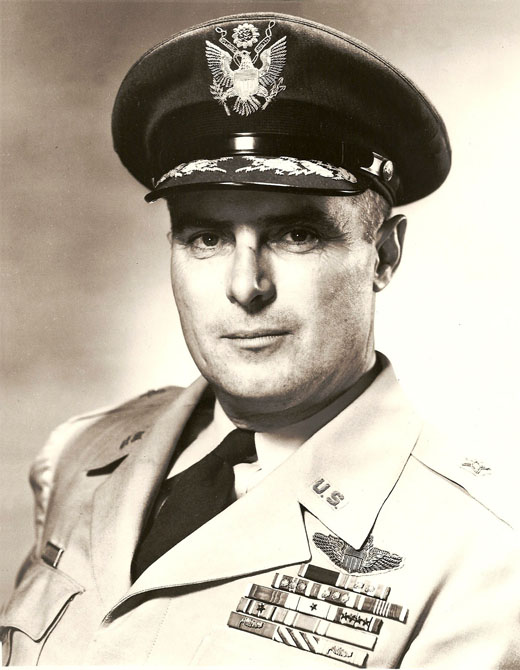 | |
Brigadier General Robert F. Travis |
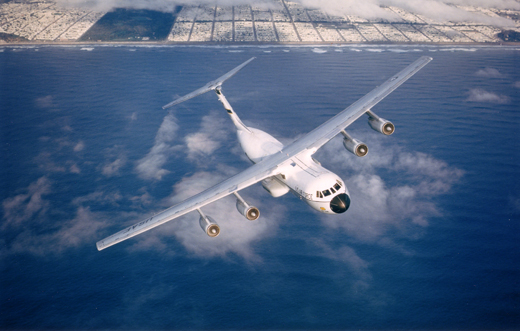 | |
C-141A Starlifter assigned to the 60th Military Airlift Wing, Travis AFB in the early 1970s flying over the Pacific Ocean |
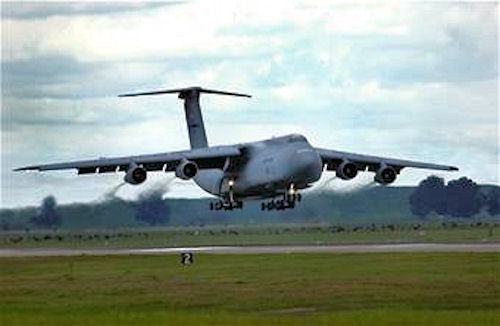 | |
C-5 Galaxy assigned to the 349th Air Mobility Wing |
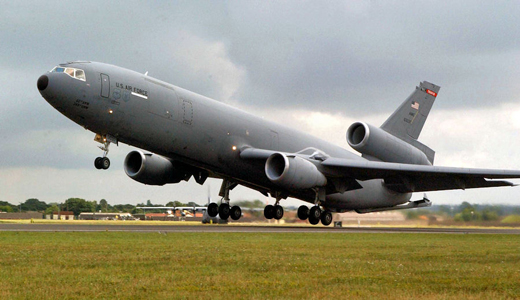 | |
KC-10A Extender operations at Travis AFB |
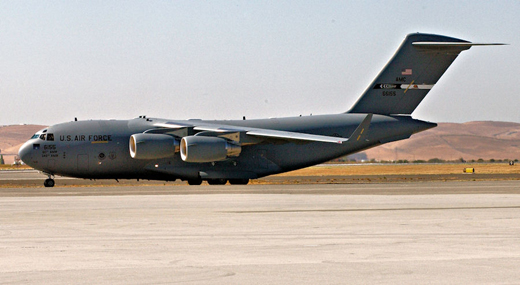 | |
C-17 Globemaster III assigned to the 60th AMW |
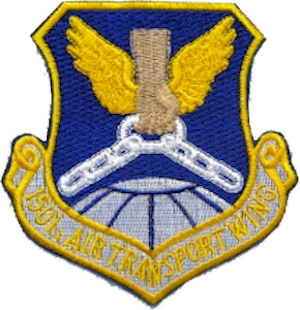 | |
Emblem of the MATS 1501st Air Transport Wing |
Originally named Fairfield-Suisun Army Air Base, construction began on Travis in June 1942. Initially, Fourth Air Force intended to station medium attack bombers at the new air base, and in the autumn of 1942, some of its aircraft used the runways for practice landings. During this period, United States Navy planes also practiced maneuvers at the same field. For a few months, in fact, the outline of the deck of an aircraft carrier was painted on one runway. This helped newly commissioned Navy pilots, flying F6F Hellcats and SB2C Helldivers, practice carrier landings and takeoffs before they were assigned to the Pacific Fleet.
Despite its plans, Fourth Air Force never officially occupied the base. On 13 October 1942, following negotiations that had begun in September, the War Department assigned the new facility to the Air Transport Command (ATC) in recognition of the base's potential to become a major aerial port and supply transfer point for the Pacific War Zone. Its proximity to rail, highway, and water transportation plus its location near San Francisco figured heavily in this decision. ATC assigned the airfield to the West Coast Sector of its Pacific Wing.
The first unit to take up permanent residence at the airfield was a group of ten enlisted men and one officer from the 914th Quartermaster Division at Hamilton Field. These supply and food service workers arrived on 10 May 1943 to prepare the base for the arrival, in turn, of the first ATC personnel. One week later, on 17 May, ATC officially activated Fairfield-Suisun AAB and activated the 23rd Ferrying (later Transport) Group on 29 May 1943. The base's primary mission during World War II was ferrying aircraft and supplies to the Pacific Theater. The installation's first commander was Lt Col. Arthur Stevenson.
By the end of World War II, Fairfield-Suisun AAB had become the West Coast's largest aerial port. The airlift of troops and supplies to occupied Japan and Korea, and the processing of war-weary returning GI's, had become its primary mission. Following the establishment of the United States Air Force as a separate service in 1947, the installation was renamed Fairfield-Suisun Air Force Base. On 1 June 1948, the Military Air Transport Service assumed jurisdiction of the base. In July, two of the base's air transport squadrons left for USAFE to assist in the Berlin Airlift.
On 1 May 1949, the Strategic Air Command (SAC) became the parent major command for Travis AFB, turning it into a major long-range reconnaissance and intercontinental bombing installation for the 9th Bomb Group/9th Bomb Wing. For the next nine years, airlift operations became secondary while Travis served as home for SAC bombers such as the B-29 Superfortress, B-36 Peacemaker, and eventually, the B-52 Stratofortress. During this period, new hangars appeared, runways were added and widened, and permanent barracks and family living quarters were built.
The base was renamed Travis Air Force Base in 1951 for Brigadier General Robert F. Travis, who was killed when a B-29 Superfortress he was flying crashed on 5 August 1950. The ensuing fire caused the 10-12 500 lb general purpose bombs in the bomb bay to detonate about 15 minutes after takeoff, killing General Travis and 18 others. Although the aircraft was carrying a Mark 4 nuclear weapon, the bomb's plutonium pit was not installed, rendering the nuclear device harmless.. The base was officially re-named Travis Air Force Base on 20 April 1951.
The Military Air Transport Service (MATS) resumed command of Travis AFB on 1 July 1958, after SAC's new dispersal policy led to the transfer of the 14th Air Division to Beale AFB, California and the 1501st Air Transport Wing (Heavy) became the host unit. On 1 January 1966, MATS was redesignated as the Military Airlift Command (MAC) and on 8 January 1966, the 60th Military Airlift Wing (60 MAW) replaced the 1501st as host unit. Over the next three decades, Travis would become known as the "Gateway to the Pacific" in its role as the principal military airlift hub in the western United States. Initially equipped with legacy C-124 Globemaster and C-133 Cargomaster aircraft from the 1501st, the year 1966 would also see the 60 MAW introduce the Air Force's new all-jet heavy airlifter, the C-141 Starlifter. In 1969, the 349th Military Airlift Wing (349 MAW) of the Air Force Reserve (AFRES) was also established as an "Associate" wing to the 60 MAW, with both units sharing the same aircraft and eventually seamlessly mixing flight crews, maintenance crews and other support personnel. In 1970, the 60 MAW and 349 MAW (Assoc) would also begin concurrently operating the Air Force's largest airlift aircraft, the C-5 Galaxy. In 1991, the 60 MAW was redesignated as the 60th Airlift Wing (60 AW) and the 349 MAW was redesignated as the 349th Airlift Wing (349 AW) the following year.
In 1992, with the reorganization of the Air Force following the end of the Cold War, Military Airlift Command (MAC) was inactivated and Travis came under the control of the newly-established Air Mobility Command (AMC). With the concurrent inactivation of Strategic Air Command (SAC) and the transfer of most of SAC's air refueling aircraft to AMC, the 60 AW gained KC-10 Extender aircraft that had been previously assigned to March AFB, California. With the inclusion of an aerial refueling mission into its long-time strategic airlift mission, the 60 AW and the 349 AW were redesignated as the 60th Air Mobility Wing (60 AMW) and the 349th Air Mobility Wing (349 AMW), the designations they continues to hold today. In 1997, the 349 AMW (Assoc) also became part of the newly-established Air Force Reserve Command (AFRC) while remaining operationally "gained" by AMC.
In 1997, the 60 AMW also shed its C-141 aircraft, which were transferred to other Air Force, AFRC and Air National Guard (ANG) wings, while retaining its C-5 and KC-10 aircraft. On 8 August 2006, the 60 AMW and 349 AMW (Assoc) again acquired a third aircraft type in their inventory with the arrival of the C-17 Globemaster III.
Major commands to which assigned
- Air Transport Command, 13 October 1942
- Military Air Transport Service, 1 June 1948
- Strategic Air Command, 1 May 1949
- Air Defense Command (Attached), 1 April 1953 - 30 June 1966
- Military Air Transport Service, 1 July 1958
- Redesignated: Military Airlift Command, 1 January 1966
- Air Mobility Command, 1 June 1992–present
Major units assignedReference for major commands assigned and major units assigned
The above content comes from Wikipedia and is published under free licenses – click here to read more.
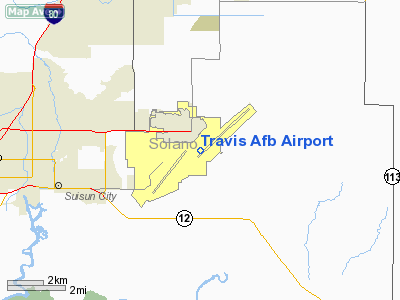
|
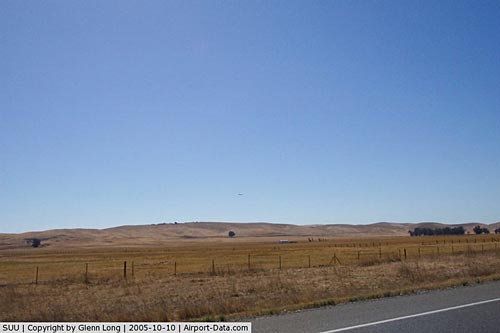 |
(Click on the photo to enlarge) |
Location
& QuickFacts
|
FAA
Information Effective: |
2006-09-28 |
|
Airport
Identifier: |
SUU |
|
Longitude/Latitude: |
121-55-39.0000W/38-15-45.6000N
-121.927500/38.262667 (Estimated) |
|
Elevation: |
62 ft / 18.90 m (Estimated) |
|
Land: |
0 acres |
|
From
nearest city: |
3 nautical miles E of Fairfield, CA |
|
Location: |
Solano County, CA |
|
Magnetic Variation: |
16E (1985) |
Owner
& Manager
|
Ownership: |
Air Force owned |
|
Owner: |
Usaf |
|
Address: |
Travis Afb
Fairfield, CA 94535 |
|
Manager: |
Base Operations (usaf) |
|
Address: |
Travis Afb
Fairfield, CA 94535 |
|
Phone number: |
707-438-2457 |
Airport
Operations and Facilities
|
Airport
Use: |
Private |
|
Segmented
Circle: |
No |
|
Control
Tower: |
Yes |
|
Attendance
Schedule: |
ALL/ALL/ALL |
|
Lighting
Schedule: |
DUSK-DAWN |
|
Beacon
Color: |
Clear-Green (lighted land airport) |
|
Landing
fee charge: |
No |
|
Sectional
chart: |
San Francisco |
|
Region: |
AWP - Western-Pacific |
|
Boundary
ARTCC: |
ZOA - Oakland |
|
Tie-in
FSS: |
SUU - Travis Afb
FSS-RANCHO MURIETA RIU-NOTAM SUU |
|
FSS
on Airport: |
No |
|
FSS
Toll Free: |
1-800-WX-BRIEF |
|
NOTAMs
Facility: |
SUU (NOTAM-d service avaliable) |
Airport
Services
|
Fuel
available: |
115 B+ |
|
Airframe
Repair: |
MAJOR |
|
Power
Plant Repair: |
MAJOR |
|
Bottled
Oxygen: |
NONE |
|
Bulk
Oxygen: |
HIGH/LOW |
|
Runway Information
Runway 03L/21R
|
Dimension: |
11001 x 150 ft / 3353.1 x 45.7 m |
|
Surface: |
PEM, |
|
Weight
Limit: |
Single wheel: 155000 lbs.
Dual wheel: 260000 lbs.
Dual tandem wheel: 470000 lbs.
Dual dual tandem wheel: 720000 lbs. |
|
Edge
Lights: |
High |
|
|
Runway 03L |
Runway 21R |
|
Longitude: |
121-57-25.0600W |
121-55-43.1200W |
|
Latitude: |
38-14-35.8500N |
38-15-49.0900N |
|
Elevation: |
36.00 ft |
53.00 ft |
|
Alignment: |
47 |
127 |
|
ILS
Type: |
LOC/GS |
|
|
Traffic
Pattern: |
Left |
Left |
|
Markings: |
Precision instrument, Good Condition |
Precision instrument, Good Condition |
|
VASI: |
4-light PAPI on left side |
4-light PAPI on left side |
|
RVR
Equipment: |
touchdown |
|
|
Runway
End Identifier: |
No |
No |
|
Centerline
Lights: |
No |
No |
|
Touchdown
Lights: |
No |
No |
|
Runway 03R/21L
|
Dimension: |
10992 x 150 ft / 3350.4 x 45.7 m |
|
Surface: |
CONC, |
|
Weight
Limit: |
Single wheel: 155000 lbs.
Dual wheel: 260000 lbs.
Dual tandem wheel: 470000 lbs.
Dual dual tandem wheel: 720000 lbs. |
|
Edge
Lights: |
High |
|
|
Runway 03R |
Runway 21L |
|
Longitude: |
121-55-35.3700W |
121-53-53.4600W |
|
Latitude: |
38-15-41.2700N |
38-16-54.4300N |
|
Elevation: |
56.00 ft |
55.00 ft |
|
Alignment: |
47 |
127 |
|
ILS
Type: |
|
ILS |
|
Traffic
Pattern: |
Left |
Left |
|
Markings: |
Precision instrument, Good Condition |
Precision instrument, Good Condition |
|
VASI: |
4-light PAPI on left side |
4-light PAPI on left side |
|
RVR
Equipment: |
|
touchdown |
|
Approach
lights: |
|
ALSF2 |
|
Runway
End Identifier: |
No |
No |
|
Centerline
Lights: |
Yes |
Yes |
|
Touchdown
Lights: |
No |
Yes |
|
Radio Navigation
Aids
|
ID |
Type |
Name |
Ch |
Freq |
Var |
Dist |
|
LV |
NDB |
Reiga |
|
374.00 |
16E |
36.2 nm |
|
TCY |
NDB |
Tracy |
|
203.00 |
15E |
41.2 nm |
|
SUU |
TACAN |
Travis |
113X |
|
17E |
1.3 nm |
|
TZZ |
VOR |
Travis |
|
116.40 |
17E |
7.4 nm |
|
CCR |
VOR/DME |
Concord |
117X |
117.00 |
17E |
14.2 nm |
|
MCC |
VOR/DME |
Mc Clellan |
029X |
109.20 |
17E |
34.6 nm |
|
SFO |
VOR/DME |
San Francisco |
105X |
115.80 |
17E |
44.1 nm |
|
STS |
VOR/DME |
Santa Rosa |
077X |
113.00 |
16E |
44.1 nm |
|
SAC |
VORTAC |
Sacramento |
099X |
115.20 |
17E |
20.8 nm |
|
SGD |
VORTAC |
Scaggs Island |
058X |
112.10 |
17E |
21.6 nm |
|
OAK |
VORTAC |
Oakland |
115X |
116.80 |
17E |
35.2 nm |
|
SAU |
VORTAC |
Sausalito |
109X |
116.20 |
17E |
37.3 nm |
|
ECA |
VORTAC |
Manteca |
107X |
116.00 |
17E |
44.1 nm |
|
LIN |
VORTAC |
Linden |
095X |
114.80 |
17E |
45.1 nm |
|
PYE |
VORTAC |
Point Reyes |
084X |
113.70 |
17E |
45.8 nm |
|
ILA |
VORTAC |
Williams |
091X |
114.40 |
18E |
48.8 nm |
|
SAC |
VOT |
Sacramento Executive |
|
111.40 |
|
25.2 nm |
|
SMF |
VOT |
Sacramento Metropolitan |
|
111.40 |
|
30.2 nm |
|
SFO |
VOT |
San Francisco Intl |
|
111.00 |
|
44.1 nm |
Remarks
- BEARING
STRENGTH RWY 03L/21R: S81 T122 ST175 SBTT590 TT332 TDT837 DDT760 TRT580.
- RSTD:
MODERATE (TKOF PERMS WITH OG/CC APVL, AIRBORNE ACFT WILL DIVERT, HOLD
OR FULL STOP; NO IFR/VFR TFC PAT ACT) AND SEVERE (TKOF, LDG AND APCH
ARE PROH WO OG/CC APVL). CTC BASE OPS OR COMD POST FOR CURRENT BIRD
WATCH COND CODE. 180� TURN RSTD TO CONCRETE PORTION OF RWY ONLY.
- CAUTION:
EXTREME BRIGHT LGT ON RAMP LCTD W SIDE OF ARPT CAN CAUSE HAZ ILLUSIONS
AND DISORIENTATION DUR DEP/LDG. RWY EDGE LGT FOR BOTH RWY LCTD MORE
THAN 10' FR EDGE OF USUABLE RWY SFC.
- CAUTION:
EXTV LGT ACFT OPR. POSSIBLE RF INTERFERENCE ALL FREQ 9 NM NE OVER VOA
TRANS. EXP WIND SHEAR BLW 2000' ON APCH TO ALL RWY. HVY C5 JET TFC IN
IMMED VCNTY. HI DENSITY VFR TFC CROS FINAL APCH AND DEP CRS.
- CAUTION:
ARR ACFT EXP HVY JET ACFT CROS RWY TO PARL TWY. BA ON RWY AND TWY MAY
BE IMPAIRED DUE TO HVY RUBBER DEPOSITS. AVOID OVFT OF FRNG RNG LCTD
550' RGT OF CNTRLINE AND 1 NM PRIOR TO APCH END RWY 21R WHEN RED BCN
IS ON OR RED FLAG IS DISPLAYED.
-
CSTMS/AG/IMG: DUE TO LTD CSTMS, PN/COORD RQR FOR ARR
OUTSIDE NML WKD HR. FOR NGT, SAT, SUN AND HOL ARR, 5 HR PN RQR.
ALL MSN COORD
THRU TRAVIS COMD POST.
- BEARING
STRENGTH RWY 03R/21L: S81 T122 ST175 SBTT590 TT332 TDT837 DDT760 TRT580.
- MISC:
ALL ACFT CARRYING DV WILL NOTIFY COMD POST NO LATER THAN 24 HR PRIOR
WITH ARR TIME AND RQR AT DSN 837-5517 OR C707-424-5517. ACFT WITH DV
CODE 7 OR ABV AND ALL INBD PAX/CARGO ACFT MUST CTC COMD POST 30 MIN
PRIOR TO LDG AND CONFIRM BLOCK TIME.
- MISC:
BASE OPS DSN 837-2836, C707-424-2836. FIRST 1000' RWY 21R AND FIRST
2900' RWY 03L CONCRETE, MID 7100' ASPHALT.
- MILITARY
USE: AERO CLUB UNICOM - 123.3
- RSTD:
MAX PERFORMANCE CLIMBS ARE PROH FOR HI PERFORMANCE ACFT. WHEN RWY 03L-21R
NOT AVBL, AIRCREW SHOULD REQ 15 MIN EARLY ENG START FOR RQR BACK TAXI
OPR. B52 ACFT TAXI OPR LTD TO TWY G, N AND M ONLY.
- RSTD:
ALL ACFT OPR RSTD DUR PHASE II BIRD WATCH COND, APRX 1 SEP- 1 APR, 1
HR PRIOR TO 1 HR AFTER SR.
- LGT:
PAPI INTENSITY NOT ADJUSTABLE. PAPI COINCIDENTAL WITH ILS GS RWY 03L
AND 21L VIS DESCENT PT FOR HGT GP 4 ACFT ONLY. PAPI RWY 03R AND 21R
PROVIDES PROPER TCH FOR HGT GP 4 ACFT ONLY. NSTD
ALSF-2 RWY 21L.
- CAUTION:
TAKE-OFF OBSTACLES RWY 3L : 122' MSL (58' AGL) PARKED KC10 TAILS 966
TO 1870' FROM DEPATURE END OF RUNWAY, 738 TO 958' LEFT OF CENTELINE.
- RSTD:
PPR REQUIRED (DSN 837-5517) EXC ALL AMC, AMC GAINED, AND AMC CONTRACT
MISSIONS. NOTE: AIRCRAFT CARRYING DV'S, EMERGENCY AIR EVAC, AND SPECIAL
AIR MISSIONS (SAM) REQUIRE PPR FOR COMMAND POST NOTIFICATION AND TRACKING
PURPOSES.
- RWY-LGTS:
RWY 21L SF.
- RSTD:
C5 OPR PROH ON TWY K BTN TWY N AND SPOT 515. ACFT LARGER THAN C17, TOW
ONLY ON TWY L.
- MISC:
"HANG GLIDER/TOW OPERATIONS ON-GOING AT MAINE PRAIRIE AIRPORT,
3 MILES NORTH OF TRAVIS, (TZZ R328/ SUU018010/ 3822N12149W) SFC TO 5000'".
- TFC
PAT REVISE TO: RECTANGULAR 1600', OVERHEAD 2100'.
- JASU
- 1(MA-1) 6(MA-1A) 1(MC-1A) 1(MC-2A) 8(A/M32A-86) 1(707 STARTING UNIT).
- FUEL
- J8.
- OIL
- O-128-133-148-156.
- TRAN
ALERT - SVC 24 HR DLY. EXP EXTV SVC DELAY WKEND AND HOL. TRAN ACFT,
EXC AMC MSN, CTC COMD POST NOT LATER THAN 15 MIN OUT FOR SVC REQ.
FLEET SVC AVBL.
- REMARKS:
SEE FLIP AP/1 SUPPLEMENTARY ARPT RMK. HEAVY CONCENTRATION OF BLACKBIRDS,
GULLS, AND OTHER MIGRATORY BIRDS IN THE APCH AND DEP ROUTES AND ALONG
INFIELD AREAS FROM 1 SEP-30 APR (PHASE II).
Based Aircraft
|
Aircraft
based on field: |
3 |
|
Military: |
3 |
Travis Afb Airport
Address:
Solano County, CA
Tel:
707-438-2457
Images
and information placed above are from
http://www.airport-data.com/airport/SUU/
We
thank them for the data!
| General
Info |
| Country |
United
States |
| State |
CALIFORNIA
|
| FAA ID |
SUU
|
| Latitude |
38-15-45.687N
|
| Longitude |
121-55-38.867W
|
| Elevation |
62 feet
|
| Near City |
FAIRFIELD
|
We don't guarantee the information is fresh and accurate. The data may
be wrong or outdated.
For more up-to-date information please refer to other sources.
|
 |



